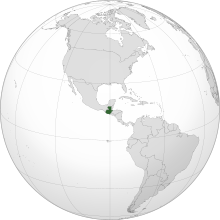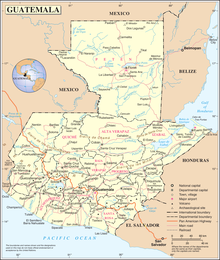
Back Гватемала Abkhazian Guatemala ACE Гуатемалэ ADY Guatemala Afrikaans Guatemala ALS ጓቴማላ Amharic Kuatimala AMI Guatemala AN Guatemala ANG ग्वाटेमाला ANP
Republic of Guatemala República de Guatemala (Spanish) | |
|---|---|
| Motto: Libre crezca fecundo[1] (Spanish) "Grow Free and Fecund" | |
| Anthem: Himno Nacional de Guatemala (English: "National Anthem of Guatemala") | |
| March: La Granadera (English: "The Song of the Grenadier") | |
| Capital and largest city | Guatemala City 14°38′N 90°30′W / 14.633°N 90.500°W |
| Official languages | Spanish |
| Recognised national languages | Mayan |
| Recognised regional languages | |
| Ethnic groups (2018)[2] | |
| Religion (2017)[3] |
|
| Demonym(s) | Guatemalan Chapín Guatemalteco (M) Guatemalteca (F) |
| Government | Unitary presidential republic |
| Bernardo Arévalo | |
| Karin Herrera | |
| Nery Ramos | |
| Legislature | Congress of the Republic |
| Independence | |
• Declared from the Spanish Empire | 15 September 1821 |
• Declared from the First Mexican Empire | 1 July 1823 |
• Declared from the Federal Republic of Central America | 17 April 1839 |
• Current constitution | 21 March 1847 |
| Area | |
• Total | 108,889 km2 (42,042 sq mi) (105th) |
• Water (%) | 0.4 |
| Population | |
• 2023 estimate | |
• Density | 166/km2 (429.9/sq mi) (80th) |
| GDP (PPP) | 2025 estimate |
• Total | |
• Per capita | |
| GDP (nominal) | 2025 estimate |
• Total | |
• Per capita | |
| Gini (2014) | 48.3[6] high inequality |
| HDI (2022) | medium (136th) |
| Currency | Quetzal (GTQ) |
| Time zone | UTC−6 (CST) |
| Date format | dd/mm/yyyy |
| Drives on | Right |
| Calling code | +502 |
| ISO 3166 code | GT |
| Internet TLD | .gt |
Guatemala,[a] officially the Republic of Guatemala,[b] is a country in Central America. It is bordered to the north and west by Mexico, to the northeast by Belize, to the east by Honduras, and to the southeast by El Salvador. It is hydrologically bordered to the south by the Pacific Ocean and to the northeast by the Gulf of Honduras.
The territory of modern Guatemala hosted the core of the Maya civilization, which extended across Mesoamerica; in the 16th century, most of this was conquered by the Spanish and claimed as part of the viceroyalty of New Spain. Guatemala attained independence from Spain and Mexico in 1821. From 1823 to 1841, it was part of the Federal Republic of Central America. For the latter half of the 19th century, Guatemala suffered instability and civil strife. From the early 20th century, it was ruled by a series of dictators backed by the United States. In 1944, authoritarian leader Jorge Ubico was overthrown by a pro-democratic military coup, initiating a decade-long revolution that led to social and economic reforms. In 1954, a US-backed military coup ended the revolution and installed a dictatorship.[8] From 1960 to 1996, Guatemala endured a bloody civil war fought between the US-backed government and leftist rebels, including genocidal massacres of the Maya population perpetrated by the Guatemalan military.[9][10][11] The United Nations negotiated a peace accord, resulting in economic growth and successive democratic elections.
Guatemala's abundance of biologically significant and unique ecosystems includes many endemic species and contributes to Mesoamerica's designation as a biodiversity hotspot.[12] Although rich in export goods, around a quarter of the population (4.6 million) face food insecurity. Other extant major issues include poverty, crime, corruption, drug trafficking, and civil instability.
With an estimated population of around 17.6 million,[13][14] Guatemala is the most populous country in Central America, the 4th most populous country in North America and the 11th most populous country in the Americas. Its capital and largest city, Guatemala City, is the most populous city in Central America.
- ^ Banco de Guatemala 1996.
- ^ "Portal de Resultados del Censo 2018". Censopoblacion.gt. Archived from the original on 17 December 2019. Retrieved 14 April 2022.
- ^ "International Religious Freedom Report for 2017: Guatemala". www.state.gov. Archived from the original on 26 September 2020. Retrieved 27 July 2018.
- ^ "Guatemala". The World Factbook (2025 ed.). Central Intelligence Agency. Retrieved 22 June 2023. (Archived 2023 edition.)
- ^ a b c d "World Economic Outlook Database, October 2024 Edition. (Guatemala)". IMF.org. International Monetary Fund. 10 October 2024. Retrieved 2 January 2025.
- ^ "GINI index (World Bank estimate)". data.worldbank.org. World Bank. Archived from the original on 2 February 2020. Retrieved 7 March 2019.
- ^ "Human Development Report 2023/2024" (PDF). United Nations Development Programme. 13 March 2024. Archived (PDF) from the original on 13 March 2024. Retrieved 13 March 2024.
- ^ Blakeley 2009, p. 92.
- ^ Cooper 2008, p. 171.
- ^ Solano 2012, pp. 3–15.
- ^ Conservation International 2007.
- ^ "World Population Prospects 2022". United Nations Department of Economic and Social Affairs, Population Division. Retrieved 17 July 2022.
- ^ "World Population Prospects 2022: Demographic indicators by region, subregion and country, annually for 1950-2100" (XSLX) ("Total Population, as of 1 July (thousands)"). United Nations Department of Economic and Social Affairs, Population Division. Retrieved 17 July 2022.
Cite error: There are <ref group=lower-alpha> tags or {{efn}} templates on this page, but the references will not show without a {{reflist|group=lower-alpha}} template or {{notelist}} template (see the help page).



